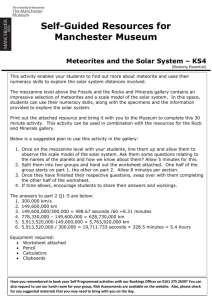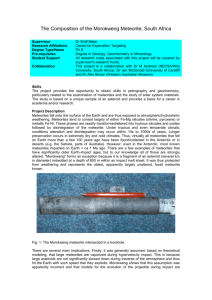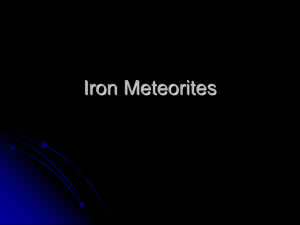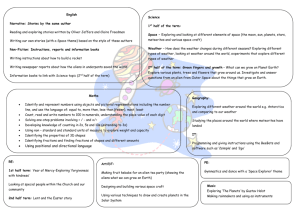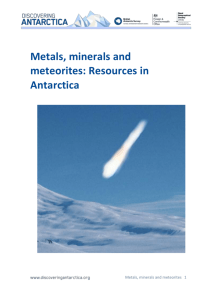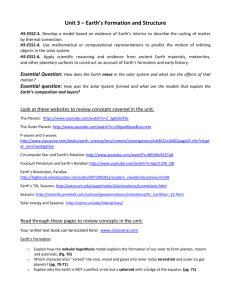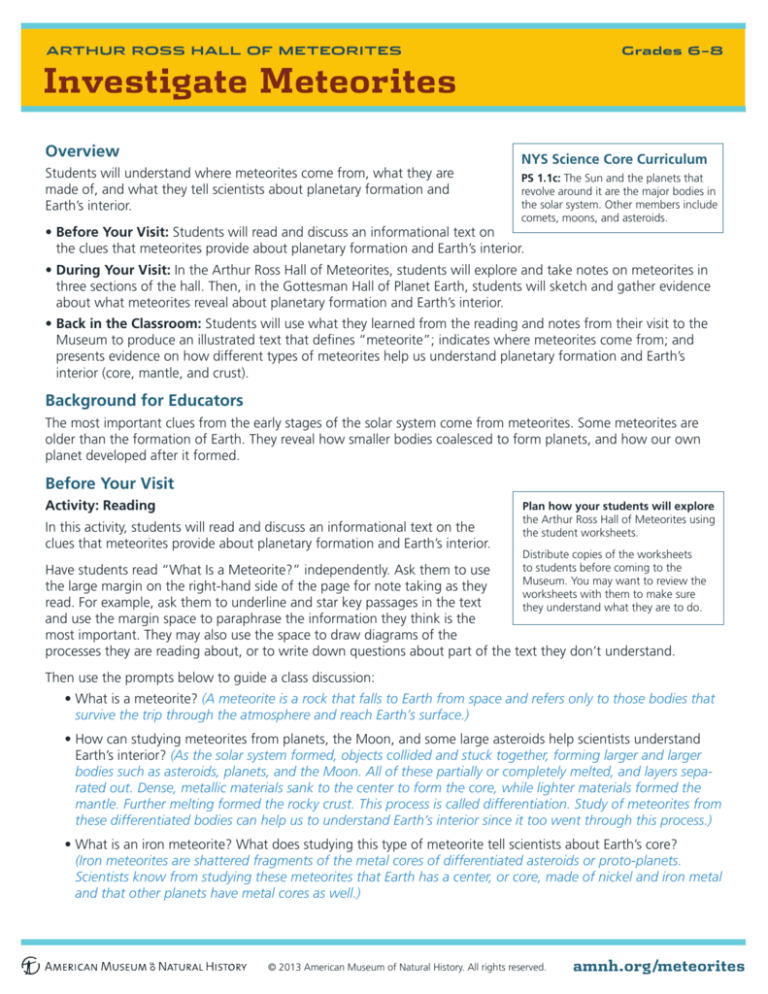
ARTHUR ROSS HALL OF METEORITES
Grades 6-8
Investigate Meteorites
Overview
Students will understand where meteorites come from, what they are
made of, and what they tell scientists about planetary formation and
Earth’s interior.
NYS Science Core Curriculum
PS 1.1c: The Sun and the planets that
revolve around it are the major bodies in
the solar system. Other members include
comets, moons, and asteroids.
• Before Your Visit: Students will read and discuss an informational text on
the clues that meteorites provide about planetary formation and Earth’s interior.
• During Your Visit: In the Arthur Ross Hall of Meteorites, students will explore and take notes on meteorites in
three sections of the hall. Then, in the Gottesman Hall of Planet Earth, students will sketch and gather evidence
about what meteorites reveal about planetary formation and Earth’s interior.
• Back in the Classroom: Students will use what they learned from the reading and notes from their visit to the
Museum to produce an illustrated text that defines “meteorite”; indicates where meteorites come from; and
presents evidence on how different types of meteorites help us understand planetary formation and Earth’s
interior (core, mantle, and crust).
Background for Educators
The most important clues from the early stages of the solar system come from meteorites. Some meteorites are
older than the formation of Earth. They reveal how smaller bodies coalesced to form planets, and how our own
planet developed after it formed.
Before Your Visit
Activity: Reading
In this activity, students will read and discuss an informational text on the
clues that meteorites provide about planetary formation and Earth’s interior.
Plan how your students will explore
the Arthur Ross Hall of Meteorites using
the student worksheets.
Distribute copies of the worksheets
to students before coming to the
Have students read “What Is a Meteorite?” independently. Ask them to use
Museum. You may want to review the
the large margin on the right-hand side of the page for note taking as they
worksheets with them to make sure
read. For example, ask them to underline and star key passages in the text
they understand what they are to do.
and use the margin space to paraphrase the information they think is the
most important. They may also use the space to draw diagrams of the
processes they are reading about, or to write down questions about part of the text they don’t understand.
Then use the prompts below to guide a class discussion:
• What is a meteorite? (A meteorite is a rock that falls to Earth from space and refers only to those bodies that
survive the trip through the atmosphere and reach Earth’s surface.)
• How can studying meteorites from planets, the Moon, and some large asteroids help scientists understand
Earth’s interior? (As the solar system formed, objects collided and stuck together, forming larger and larger
bodies such as asteroids, planets, and the Moon. All of these partially or completely melted, and layers separated out. Dense, metallic materials sank to the center to form the core, while lighter materials formed the
mantle. Further melting formed the rocky crust. This process is called differentiation. Study of meteorites from
these differentiated bodies can help us to understand Earth’s interior since it too went through this process.)
• What is an iron meteorite? What does studying this type of meteorite tell scientists about Earth’s core?
(Iron meteorites are shattered fragments of the metal cores of differentiated asteroids or proto-planets.
Scientists know from studying these meteorites that Earth has a center, or core, made of nickel and iron metal
and that other planets have metal cores as well.)
© 2013 American Museum of Natural History. All rights reserved.
amnh.org/meteorites
ARTHUR ROSS HALL OF METEORITES
Grades 6-8
• What are the two types of stony meterorites? What do they tell us about the solar system and Earth?
(Unmelted stony meteorites called chondrites tell us about the early solar system because they have remain
unchanged. Partially melted stony meteorites, called achondrites, show that when planets and asteroids
melted, they separated into metal and stony parts.)
• What are stony-iron meteorites made of? What do some scientists theorize that pallasites show about
Earth’s formation?
(Stony-iron meteorites are a mixture of metal and rock. Some scientists theorize that pallasites are samples of
the boundary between the metal core and the olivine-rich mantle around it.)
• What are some things that the study of meteorites has helped scientists understand our solar system?
(They provide evidence for the beginnings of our solar system, how planets and asteroids formed, and how
impacts of large meteorites have altered Earth’s history and life on our planet.)
Activity: Explore Density
In this activity, students will investigate why some materials sink to the core of a planet while others float to the
crust. This experiment uses marshmallow fluff and molasses to illustrate the concept of planet differentiation.
sHave students determine the density of marshmallow fluff and molasses by filling identical beakers to the same
level with each material and weighing both beakers. Then, place a dome of marshmallow fluff in the bottom of
a clear bowl. Have students thin out fluff near edges and add molasses until it is about 3” deep. Ask students to
predict what will happen and why. Then, observe what happens. Which material ends up on top? Why? Discuss
the results with students and have them draw conclusions about why dense material is at the core of
differentiated planets.
During Your Visit
Arthur Ross Hall of Meteorites
1st floor (30-40 minutes)
In the “Building Planets” section of the hall, students will use the worksheet to sketch and gather evidence about
what meteorites reveal about planetary formation and Earth’s interior.
Gottesman Hall of Planet Earth
1st floor (30 minutes)
Students will explore various sections of the hall to gather additional evidence about how scientists understand
Earth’s interior:
• In the “How Earth Formed” section, have students explore the density blocks and diagrams to understand
more about how Earth’s layers are organized.
• In the “Earthquakes” section, have students examine what seismic waves tell us about the make-up of
Earth’s interior.
• In the “Volcanism” sections, have students watch videos of scientists visiting lava flows to explore how lava
flows help scientists understand the make-up of Earth’s interior.
Back in the Classroom
Activity: Write an Illustrated Text
Using what they’ve learned from the pre-visit reading and their Museum visit, have students create an illustrated
text that:
• defines “meteorite”
• indicates where meteorites come from
• presents evidence on how different types of meteorites help us understand planetary formation and Earth’s
interior (core, mantle, and crust)
© 2013 American Museum of Natural History. All rights reserved.
amnh.org/meteorites
ARTHUR ROSS HALL OF METEORITES
Grades 6-8
Student Reading
Meteorites: Clues to Planetary Formation
What is a meteorite?
In simplest terms, a meteorite is a rock that falls to Earth from space. The word
meteorite refers only to those rocks that survive the trip through the atmosphere
and reach Earth’s surface.
Meteorites are rocks, but not like Earth rocks. Most meteorites are far older. They
provide some of the only samples we have of other objects — planets, asteroids,
and possibly comets — in our solar system. Some meteorites even contain tiny
particles that formed around other stars that existed before our Sun. Studying
meteorites helps us understand how the solar system and the bodies in it formed.
Where do meteorites come from?
Our solar system began to take shape some 4.6 billion years ago. At that time, the
Sun and planets as we know them now did not exist. Back then a large cloud of
gas and dust known as the solar nebula swirled around the developing Sun.
As the solar system formed within this swirling cloud, countless small objects
collided and stuck together. Gradually, they formed larger and larger bodies such
as asteroids and planets.
An artist’s rendering of the early solar system.
Photo © William K. Hartmann
© 2013 American Museum of Natural History. All rights reserved.
amnh.org/meteorites
ARTHUR ROSS HALL OF METEORITES
Grades 6-8
Meteorites: Clues to Planetary Formation
page 2
Some meteorites are pieces of planets, the Moon, and some large asteroids that
show evidence of partial or complete melting within those bodies. This melting
was the result of intense heat and pressure that occurred as the objects accreted.
Accretion is when materials come together under the influence of gravity to form
a planet, moon, asteroid, or comet. When the materials came together and the
body increased in size, the heat and pressure increased. This caused melting. As
this melting occurred, layers separated out in a process called differentiation. Dense
metallic materials sank to the center where it crystallized to form the core. Less
dense materials formed the mantle. Further melting formed the outer rocky crust.
Meteorites from these differentiated bodies are rare finds but very valuable because
they help us understand how planets formed and what their deep interiors are
made of.
What does studying different types of meteorites tell us?
Meteorites are all rocks from space. But they are not all alike. There are three main
groups: iron meteorites, stony meteorites, and stony-iron meteorites. Each group
of meteorites is split into many more classes and types. The class or type depends
upon the minerals they contain, their chemistry and their structure. The different
types provide us with information about a range of processes that occurred earlier
in our solar system’s history.
1. Stony Meteorites
The most common meteorites are stones. They could easily be mistaken for
ordinary rocks from Earth. Stony meteorites fall into two main groups. Chondrites
— the more common type, are the oldest rocks formed in our solar system. These
ancient stones offer a record of the solar system in its infancy. Since many have not
changed, scientists use the age of these rocks to determine the age of our solar
system. They are clues to what conditions were like when the solar system was
young. They also give us hints about the elements that exist in our solar system.
Achondrites are pieces of planetary bodies that partially melted while they were in
space, as described above. Studying these meteorites teaches us about the history
of melting planetary bodies like Earth, the Moon, and the other rocky planets
and moons.
© 2013 American Museum of Natural History. All rights reserved.
amnh.org/meteorites
ARTHUR ROSS HALL OF METEORITES
Grades 6-8
Meteorites: Clues to Planetary Formation
page 3
2. Iron Meteorites
The meteorites known as irons
are more than 98 percent metal.
Almost every iron meteorite comes
from the iron core of an asteroid
or planetary bodies. As described
above, the iron core formed when
the asteroid differentiated. Studying these meteorites is one of the
ways that scientists know that
Earth has a core made of nickel
and iron metal. The other planets
have metal cores as well.
Photo © AMNH/D.Finnin
3. Stony-Iron Meteorites
Stony-iron meteorites are a mixture of metal and rock. There are two different
kinds: mesosideroites and pallasites. The Stony-Iron meteorites called mesosiderites
form when asteroids collide. In the crash, the molten metals and solid pieces of silicate rocks of both asteroids get mixed. Because of that, mesosiderites may record
the history of both meteorites.
Other stony-iron meteorites are called pallasites. Pallasites contain green crystals of
the mineral olivine that are surrounded by metal. These meteorites are extremely
rare. They make up less than one percent of all known meteorites. Some scientists
think that they resemble the material that makes up the boundary between Earth’s
core (made of metal) and mantle (made mostly of olivine).
© 2013 American Museum of Natural History. All rights reserved.
amnh.org/meteorites
ARTHUR ROSS HALL OF METEORITES
Grades 6-8
Student Worksheet
Go to the “Building Planets” section of the hall.
1. In the “Crust” exhibit, select a meteorite. Sketch and label it.
What is the common rock type in these
meteorites?
Why did the rocky material rise to the surface
when the planets formed?
2. In the “Mantle” exhibit, select a meteorite. Sketch and label it.
What are these Stony-Iron Pallasite meteorites
made of?
Where do they come from?
3. In the “Core” exhibit, select a meteorite. Sketch and label it.
What are these meteorites made of?
Where do they come from?
© 2013 American Museum of Natural History. All rights reserved.
amnh.org/meteorites
ARTHUR ROSS HALL OF METEORITES
Grades 6-8
Student Worksheet
Go to the “Building Planets” section of the hall.
Answer Key
1. In the “Crust” exhibit, select a meteorite. Sketch and label it.
What is the common rock type in these
meteorites?
(basalt)
Why did the rocky material rise to the surface
when the planets formed?
(It rose because it was less dense.)
2. In the “Mantle” exhibit, select a meteorite. Sketch and label it.
What are these Stony-Iron Pallasite meteorites
made of?
(iron mixed with Olivine crystals)
Where do they come from?
(These meteorites come from the region
between the crust and the core of a
differentiated asteroid.)
3. In the “Core” exhibit, select a meteorite. Sketch and label it.
What are these meteorites made of?
(iron)
Where do they come from?
(These meteorites come from shattered
fragments of the metal cores of
differentiated asteroids.)
© 2013 American Museum of Natural History. All rights reserved.
amnh.org/meteorites


